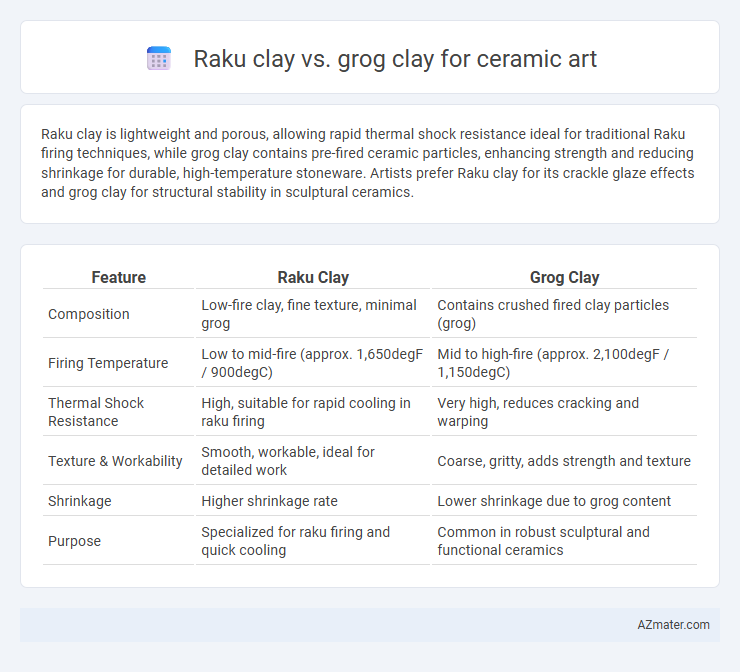Raku clay is lightweight and porous, allowing rapid thermal shock resistance ideal for traditional Raku firing techniques, while grog clay contains pre-fired ceramic particles, enhancing strength and reducing shrinkage for durable, high-temperature stoneware. Artists prefer Raku clay for its crackle glaze effects and grog clay for structural stability in sculptural ceramics.
Table of Comparison
| Feature | Raku Clay | Grog Clay |
|---|---|---|
| Composition | Low-fire clay, fine texture, minimal grog | Contains crushed fired clay particles (grog) |
| Firing Temperature | Low to mid-fire (approx. 1,650degF / 900degC) | Mid to high-fire (approx. 2,100degF / 1,150degC) |
| Thermal Shock Resistance | High, suitable for rapid cooling in raku firing | Very high, reduces cracking and warping |
| Texture & Workability | Smooth, workable, ideal for detailed work | Coarse, gritty, adds strength and texture |
| Shrinkage | Higher shrinkage rate | Lower shrinkage due to grog content |
| Purpose | Specialized for raku firing and quick cooling | Common in robust sculptural and functional ceramics |
Introduction to Raku Clay and Grog Clay
Raku clay is specially formulated for rapid firing techniques, exhibiting high thermal shock resistance that allows easy removal from the kiln while hot, ideal for raku pottery. Grog clay contains ground fired clay particles (grog) that improve the clay's strength, reduce shrinkage, and enhance texture, making it suitable for hand-building and larger sculptural ceramic pieces. Both clays serve distinct purposes in ceramic art: raku clay excels in raku firing processes, while grog clay offers durability and structural support during wheel-throwing and sculpting.
Composition and Material Differences
Raku clay typically contains a lower percentage of grog and is formulated for thermal shock resistance, featuring a composition rich in kaolin and ball clay to withstand rapid heating and cooling during firing. Grog clay incorporates a higher amount of grog--pre-fired ceramic particles--that enhances strength and reduces shrinkage, making it ideal for sculptural work and hand-building techniques. The primary material difference lies in grog content, which affects texture, firing temperature tolerance, and the clay's overall durability in ceramic art applications.
Texture and Workability
Raku clay features a smooth texture that enhances ease of hand-building and detailed sculpting, making it ideal for artists seeking refined finishes and rapid firing cycles. Grog clay contains pre-fired clay particles that add a gritty, coarse texture, improving structural stability and reducing shrinkage but requiring more effort to manipulate. The workability of Raku clay supports delicate shaping with less resistance, whereas grog clay's abrasive quality increases durability at the cost of softness during forming.
Firing Temperature and Process
Raku clay is formulated to withstand rapid thermal shock during low-fire Raku firing, typically between 1,650degF and 1,850degF (900degC to 1,010degC), ensuring crack resistance during quick cooling. Grog clay contains pre-fired clay particles (grog) that improve durability and reduce shrinkage, allowing it to endure higher firing temperatures up to 2,300degF (1,260degC) in stoneware or porcelain processes. The porous nature of Raku clay suits its quick-cooling reduction environment, while grog clay's structure supports extended high-temperature firings, enhancing strength and texture.
Durability and Strength Comparison
Raku clay is known for its porous structure and lower firing temperature, resulting in moderate strength and durability suitable for decorative ceramic art but less ideal for functional ware. Grog clay contains pre-fired clay particles that enhance structural support, reduce shrinkage, and significantly increase both durability and strength, making it ideal for heavy-use ceramics and sculptural pieces. The inclusion of grog improves thermal shock resistance, which is critical for projects requiring resilience to rapid temperature changes.
Surface Finish and Visual Effects
Raku clay produces a smooth surface finish with a distinctive crackled texture resulting from rapid cooling during firing, enhancing the tactile and visual appeal of ceramic art. Grog clay incorporates pre-fired clay granules, creating a rougher, more textured surface that provides rustic, earthy visual effects and reduces shrinkage and warping. Artists seeking vibrant, dynamic finishes often prefer raku clay, while those aiming for durability and organic textures favor grog clay.
Suitability for Various Ceramic Art Techniques
Raku clay is ideal for low-fire techniques and rapid cooling processes due to its porous structure, which reduces thermal shock during the raku firing cycle. Grog clay, enriched with pre-fired clay particles, offers enhanced strength and durability, making it suitable for hand-building, sculpting, and high-fire stoneware or porcelain ceramics. Artists often select raku clay for decorative, vibrant surface finishes, while grog clay supports robust, functional ware and textured artistic effects.
Handling and Sculpting Ease
Raku clay contains larger grog particles and a porous texture, making it easier to handle and less prone to cracking during rapid firing and cooling in ceramic art. Grog clay, infused with finer grog, offers better structural support but can feel slightly rougher and denser, requiring more effort when sculpting detailed pieces. Both clays enhance workability, but Raku clay excels in ease of manipulation and reduced warping risks during the raku firing process.
Cost and Availability
Raku clay is generally more affordable and widely available through specialty pottery suppliers, making it a cost-effective choice for artists focused on surface texture and quick firing processes. Grog clay contains pre-fired granular material, increasing its price due to enhanced structural strength and heat resistance, which is essential for functional ceramics but limits availability primarily to industrial suppliers. The cost difference often reflects the clay's intended use, with Raku clay suited for decorative pieces and Grog clay favored in applications requiring durability and reduced shrinkage.
Choosing the Right Clay for Your Ceramic Art
Choosing the right clay for your ceramic art depends on the desired texture, firing temperature, and finish. Raku clay is porous and low-fire, ideal for rapid cooling and crackled surface effects, while grog clay contains pre-fired particles that add strength and reduce shrinkage, making it suitable for sculptural and functional pieces requiring durability. Selecting between Raku and grog clay hinges on your project's structural demands and aesthetic goals.

Infographic: Raku clay vs Grog clay for Ceramic art
 azmater.com
azmater.com